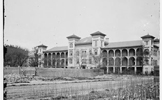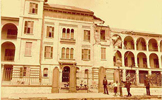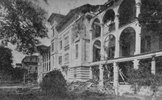At the time of the earthquake, Roper Hospital was located on the corner of Queen and Mazyck streets, near the grounds of the Workhouse, Jail, and Poor House, and adjacent to the medical college. Opened in 1856 and subsidized by the city to treat “sick, maimed and diseased paupers . . . without regard of complexion, religion or nation,” the hospital had served as a Confederate Hospital and prison for Union soldiers during the Civil War. A board of commissioners appointed by the City Council in 1880 had recommended replacement of the hospital, which treated ten thousand patients a year, but few steps were taken in that direction.
On the night of the earthquake, August 31, 1886, a tower imploded at Roper, bringing down part of the front wall and blocking the main entrance. Two passersby were killed. Medical students groped their way to a side door and began to evacuate patients, discovering two men lifeless in their beds, covered with debris. An eighteen-year-old nurse was also killed, crushed in the act of helping someone else crawl to safety. Attendants carried the patients into the frame outbuildings—kitchens, wash-houses, and morgues.
The News and Courier reported on September 6, 1886, “The Roper Hospital was, perhaps, more seriously damaged than any public institution in the city.”
Immediately after the earthquake, Dr. A. B. Rose arranged to use the Agricultural Hall on Meeting Street as a temporary hospital. (The Agricultural Hall stood on the site where the Gibbes Museum of Art is now located.) On the day after the earthquake, Wednesday, September 1, 110 patients, from both Roper and City hospitals, were moved to the Agricultural Hall. According to the News and Courier, the temporary quarters were “admirably arranged,” with a clear separation between the races and the sexes.
The newspaper continued, “Too much praise cannot be awarded Mr. W. D. Hard, the superintendent, for his energy and administrative ability in this matter. The medical and surgical staff and the nurse quarters are rather crude, and there is no ‘dead house,’ but these will be perfected in time.”
The following year, using funds donated to the city for earthquake relief, City Council began construction of a new facility at the corner of Lucas (now Jonathan Lucas) and Calhoun streets, which when it opened in May 1888 became known as Memorial Hospital. The city refused to make repairs to the former Roper Hospital, spurring a long feud with the Medical Society of South Carolina. In 1891 the Medical Society paid for the renovations to the old Roper Hospital, but funds were unavailable for its operation. Sold in 1892, the building was converted into an apartment house. In 1906, after a period of renovations, the Memorial Hospital reopened as Roper Hospital.



